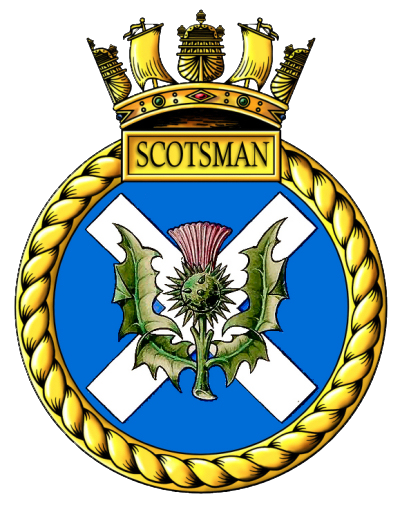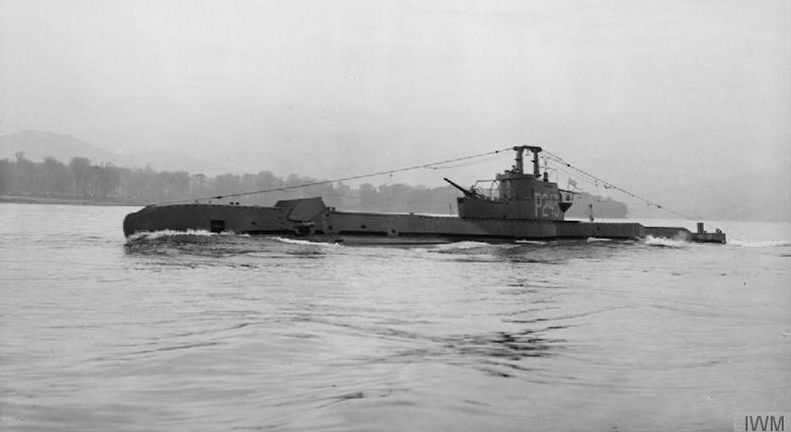S-Class Submarine

Battle Honours
None
Specifications
Builder: Scotts Shipbuilding & Engineering Co. Greenock, Scotland, United Kingdom
Displacement: 814 tons
Length: 217 ft
Beam: 23 ft 8 in
Draught: 11 ft
Propulsion: 2 × 950 bhp (708 kW) diesel engines, 2 × 650 hp (485 kW) electric motors driving two propellers
Speed: 14.75 knots (16.97 mph; 27.32 km/h) surfaced. 9 knots (10 mph; 17 km/h) submerged
Range: 7,500 Nautical miles surfaced (8,600 mi; 13,900 km) at 10 knots (12 mph; 19 km/h) 120 Nautical miles submerged ( 140 mi; 220 km) at 3 knots (3.5 mph; 5.6 km/h)
Armament: 6 × bow & 1 stern 21 in (533 mm) torpedo tubes – carried 13 torpedoes or 12 mines; 1 × three-inch (76 mm) gun (QF 4-inch deck gun; 1 × 20 mm Oerlikon AA gun; 3 × .303 calibre machine guns
Crew complement: 48
Commanding Officers
Lt. Alan Hamilton Barnett Anderson, DSC, RNR 15 May 1944 - 18 Dec 1945
Lt. R.H. Akeroyd DSC. Dec. 1945 - Apr. 1946
Lt. J.E.F. Dickson. May 1946
Lt. Cdr. J.A.L. Wilkinson. Apr. 1951
Lt. Cdr. H.R. de C. Dutton. Oct. 1954
Lt. T.R. Duchesne. Dec. 1959
Related items
None
Reminiscences
None
Gallery
None
H.M. S/M SCOTSMAN
PAGE UNDER CONSTRUCTION
Read aloud

Image copyright IWM (FL 3533)
History
She was ordered from Scotts Shipbuilding & Engineering Co., Greenock, Scotland, on December 20th 1941, one of the batch three boats ordered as part of the third group of S class submarines for the Royal Navy. Her keel was laid down on April 15th 1943. She was launched on August 18th 1944.
Beginning on November 22nd 1944 SCOTSMAN began her builder’s trials in the Clyde area, her full speed trials on the Arran measured mile had to be broken off due to a defect to the port engine. She commissioned as H.M. Submarine SCOTSMAN at Greenock on December 9th 1944 under the command of Lieutenant A.H.B. Anderson, DSC, RNR. She was the only RN vessel to bear this name. She completed her full speed and steering trials, and a W/T test on December 11th. She returned to the Scotts yard on competition of each set of trials.
She departed her builder’s yard for Holy Loch on February 6th to begin a period of trials and training in the Clyde area, arrived there on the same day. Here she conducted Torpedo, Gunnery, Bombardment, D/F and RDF exercises and performed simulated day and night attacks, both submerged and surface actions. She also performed trials at the torpedo firing range at Arrochar. Local vessels acted as targets.
Allocated to the British Pacific Fleet
H.M. Submarine SCOTSMAN departed Holy Loch for Gibraltar on the first leg of her passage to the Far East on June 11th 1945. She sailed in company with sister boat SPUR and was joined by the T Class boat H.M. Submarine TURPIN.
Post War history
H.M. Submarine SCOTSMAN was on passage to t Subic Bay to join the 8th Submarine Flotilla attached to HMS Maidstone when the Japanese surrender was announced on August 15th 1945; she arrived on station two days later. After a visit to Hong Kong Scotsman returned to the UK arriving at Rothesay on December 7th 1945 and placed in reserve.
After the war the S Class boats were refitted to install a folding snorkel mast aft of the control tower, an improved sonar mounted in a dome on the casing above the forward dive planes, and the main deck gun was removed. The snorkel allowed a submarine to cruise on diesel engines while submerged allowing the batteries to be recharged without the need to surface and risk detection by an enemy. When raised the ‘snort’ was the only part of the boat above the surface drawing in clean air while discharging the toxic diesel exhaust. Her Cold War service is unclear but she remained in service until the early 1960s; she was scrapped at Troon, Scotland on November 19th 1964.
Last modified: 23 February 2023
Primary information sources
Additional sources:
uboat.net entry for H.M. Submarine SCOTSMAN
Comments (0)